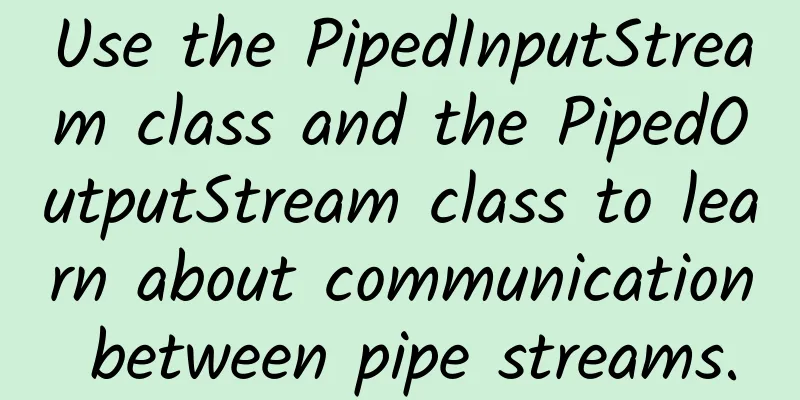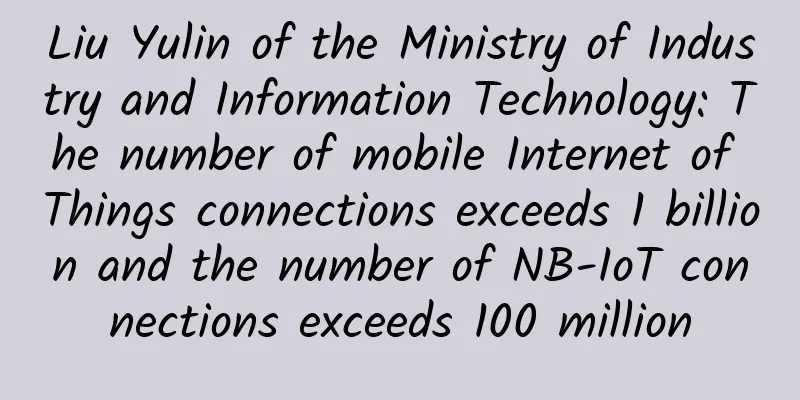Use the PipedInputStream class and the PipedOutputStream class to learn about communication between pipe streams.

|
Hello everyone, I am a Java expert. PrefaceUse PipedInputStream and PipedOutputStream in the application to create communication between pipes. A PipedInputStream instantiation object and a PipedOutputStream instantiation object are connected to generate a communication pipe. PipedInputStream is used to read written data from the pipe, and PipedOutputStream is used to write data to the pipe. Use PipedInputStream and PipedOutputStream for communication between threads. Use PipedInputStream and PipedOutputStream to learn about communication between pipe streams. Next, let's learn together! 1. PipedInputStream Class1. PipedInputStream class Piped input stream, which can be connected to a piped output stream. The piped input stream provides the bytes of all data to be written to the piped output stream. 2. PipedInputStream class construction method: (1) public PipedInputStream(): Creates a piped input stream object, which is not yet connected. (2) public PipedInputStream(PipedOutputStream out): Creates a piped input stream, which is connected to the piped output stream specified by the parameter out. As shown below:
3. The PipedInputStream class methods are: (1) int read(): reads the next byte of data. (2) int read(byte []b, int off, int len): reads len bytes of data into a byte array. The off parameter indicates the offset and len indicates the length of the read data. (3)void receive(int b): receives one byte of data. (4) void connect(PipedOutputStream src): indicates that the piped input stream is connected to the piped output stream src (5) int available(): indicates that there is nothing to prevent reading bytes from the input stream. (6)void close(): means closing the stream. 2. PipedOutputStream Class1. The PipedOutputStream class is a piped output stream, which can be used to write data to the pipe. 2. PipedOutputStream class construction method: (1) public PipedOutputStream(): Creates a piped output stream object, which is not yet connected. (2) public PipedOutputStream(PipedInputStream in): Creates a piped output stream, which is connected to the piped input stream specified by the parameter in. As shown below:
3. The PipedOutputStream class methods are: (1) void close(): means closing the stream. (2) void connect(PipedInputStream snk): indicates that the piped output stream is connected to the piped input stream. (3) void flush(): Flushes the output stream and forces any buffered output bytes to be written out. (4)void write(int b): Writes the specified byte to the pipe output stream. (5) void write(byte[] b, int off, int len): Writes len bytes of the specified byte array starting at offset off to the piped output stream. 3. Use PipedInputStream and PipedOutputStream to learn about communication between pipeline streams1. Code implementation:
The result of the operation is shown in the figure below: In the above code, a PipedInputStream object and a PipedOutputStream object are used to connect to generate a communication pipe. Two threads are written, one thread is used for the keyboard input data pipe output stream, and the other thread is used to read the written data in the pipe. These two classes are used to realize the communication between threads. IV. ConclusionThis article mainly introduces the PipedInputStream class, the PipedOutputStream class, and how to use the PipedInputStream class and the PipedOutputStream class to learn about communication between pipeline streams. The PipedInputStream class is a pipeline input stream that can be connected to a pipeline output stream. The pipeline input stream provides the bytes of all data to be written to the pipeline output stream. PipedInputStream introduces its construction method and methods. The PipedOutputStream class is a pipeline output stream that can be used to write data to a pipeline. PipedOutputStream introduces its construction method and methods. Use the PipedInputStream class and the PipedOutputStream class to learn about communication between pipeline streams. I hope that this article will be helpful to you! This article is reprinted from the WeChat public account "Java Advanced Learning Exchange", which can be followed through the following QR code. To reprint this article, please contact the Java Advanced Learning Exchange public account. |
<<: Reconnect the campus network after it is disconnected. Use crawlers to fix it!
>>: Seven factors to consider in network redundancy design
Recommend
5G Massive MIMO Says Goodbye to Power-hungry 5G Base Stations
The attacks on the large-scale construction of 5G...
Summary information: Casbay/Eurasia Cloud/ZgoCloud/Asia Cloud/Nai Cloud
This week I will continue to share some host info...
Edge Data Centers and the Impact of 5G
A new category of data center will become a major...
As the 5G era approaches, mobile bearer networks face new challenges
As 5G commercialization approaches, 5G technology...
Everyone is waiting for 5G, what is 5G waiting for?
At the end of 2013, the Ministry of Industry and ...
World Cup employees are distracted and use enterprise-level routing to control
The World Cup has entered the semi-finals, with F...
5G commercialization process accelerates operators to promote network intelligent transformation
The new round of technological changes continues ...
Thoroughly understand cross-domain issues SpringBoot helps you unimpeded
Environment: SpringBoot2.7.16 1. Introduction Cro...
[6.18] edgeNAT 40% off on all VPS annual payments, starting at 360 yuan for annual payments in Hong Kong/Korea/US data centers
edgeNAT is a Chinese hosting company established ...
Digital Ecosystem Conference | "Wisdom comes from gathering, power comes from integration" - 2021 Digital Ecosystem Conference grandly held
Digital ecology has been elevated to a national s...
The IPv6 era is coming, and every grain of sand in the world can have an IP
When it comes to IPv6, I think most people think ...
Kunpeng University Tour is coming soon. How can the Sichuan-Chongqing Twin Cities Economic Circle be without Kunpeng?
[51CTO.com original article] At 2:00 pm on Thursd...
Replacing with a new one doesn’t work? Learn how to adjust the wireless router signal
Whether it is Tieba, Weibo or the discussion area...
What are the options for 4-port/8-port/16-port/24-port Gigabit POE switches?
POE power supply technology has become the darlin...
5G and edge computing are a perfect match
Enterprise IT leaders have heard a lot about edge...









